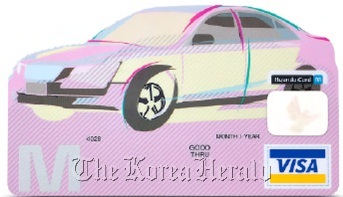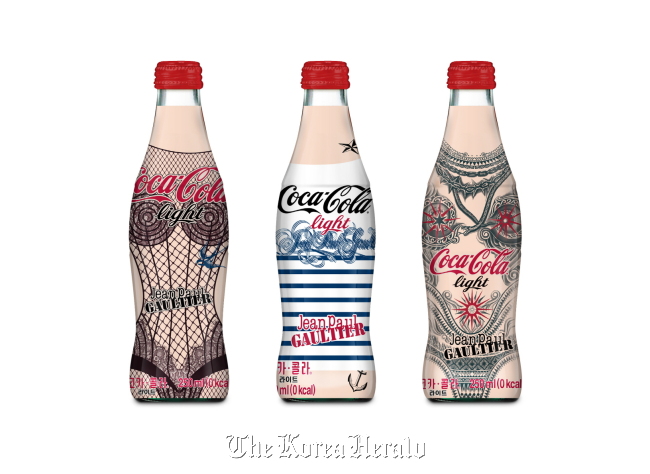More than beautify: design gives new life to business
By Korea HeraldPublished : July 19, 2012 - 20:05
Innovative designs lead to sales and brand recognition
The following is the second in a series of articles on various aspects of design prepared in anticipation of the Herald Design Forum on Sept. 19-21. ― Ed.
Credit card edges look all the same when lined up in a wallet. Hyundai Card took notice of this simple and neglected fact in 2007 and colored its 0.8 mm-thick edges with vivid colors.
The tiny difference, called “color core” design, contributed much to making the new player in the credit card industry into one of the market leaders.
“The idea was that more colorful ones will be pulled out more often, and it was right on the mark,” said Kevin Cha, PR official at Hyundai Card.
Since it started investing in card design innovations in 2003, the company has seen increased brand recognition and sales.
The creations even topped the 2011 “Good Design” survey conducted among 136 designers by Monthly Design, a South Korean design magazine, beating the mega-hit animation character “Pororo.”
The following is the second in a series of articles on various aspects of design prepared in anticipation of the Herald Design Forum on Sept. 19-21. ― Ed.
Credit card edges look all the same when lined up in a wallet. Hyundai Card took notice of this simple and neglected fact in 2007 and colored its 0.8 mm-thick edges with vivid colors.
The tiny difference, called “color core” design, contributed much to making the new player in the credit card industry into one of the market leaders.
“The idea was that more colorful ones will be pulled out more often, and it was right on the mark,” said Kevin Cha, PR official at Hyundai Card.
Since it started investing in card design innovations in 2003, the company has seen increased brand recognition and sales.
The creations even topped the 2011 “Good Design” survey conducted among 136 designers by Monthly Design, a South Korean design magazine, beating the mega-hit animation character “Pororo.”

Some of its other notable card designs include the first-ever transparent card produced in 2003; “The Black” card designed by top designer Karim Rashid and the car-shaped “free-form” card in 2005; and the most recent one uses liquid metal, the strongest metal on earth used in making artificial joints. It emphasizes the message that the card is “a new type of money that can never be damaged,” according to the company.
Before Hyundai Card started paying attention to designs, barely 300,000 won to 500,000 won were put into creating simple plastic card plates named “gold” or “platinum,”said Cha.
“Now we have a design team of about 40 designers, which is rare in the financial industry. We change card designs at least every two years. Young or female customers especially show much interest in the designs and some even choose credit cards depending on the design rather than promised services,” he said.
“It is certain that design influences the brand recognition and sales.”
Design is becoming one of the core capacities in building up a business.
According to Korea Institute of Design Promotion, investment in design requires only one-third of R&D investment costs, but brings out about an effect three times bigger in terms of sales.
The institute’s research of 49 small and medium-sized businesses with successful designs showed that each invested an average of 260 million won to 300 million won on design and achieved a sales increase of about 220-fold.
Kia Motors is another company that saw dramatic changes after investing in design. It recruited Peter Schreyer, the acclaimed former Audi/Volkswagen designer considered one of the world’s top three car designers along with Chris Bangle and Walter de Silva, as the chief design officer in 2006, who awakened the importance of design for the company.
The Kia family look-of-the-tiger nose grille and the innovative designs of the box car Soul and popular sedan K5 were created by Schreyer. The carmaker’s designs swept international awards, including world’s top three design awards ― iF, reddot and IDEA. And sales soared as well: The company sold about 254 million cars in the global market last year, an 81.6 percent increase compared to 2008. In the first half of this year, it has already sold nearly 140 million.

In some cases, designs create value beyond increased sales and brand recognition. The slender yet curvaceous bottle design of Coca-Cola, created in 1915, for example, has taken its place as one of the representative images of modern culture, inspiring many artworks and films.
Praised by British designer Stephen Bayley as the “most beautiful and expressive masterpiece in industrial design,” the bottle was the first-ever consumer product to be on the cover of the Time magazine in 1950.
Since 2003, the company has been rolling out limited-edition bottles designed in collaboration with fashion designers, including Karl Lagerfeld and Jean Paul Gauitier, which caught the eyes of art collectors.
“The limited edition bears more value than a mere package; it is becoming art that reflects the trend of the time,” said a PR official at Coca-Cola.
Recognizing the power of design, public institutions are eager to support companies, especially small- and medium-sized businesses, enhance design competence.
Korea Institute of Design Promotion runs an education program on design management for company CEOs and also plans to open a design research center in the latter half this year to systematically support them. A budget of 2.5 billion won is set aside to support design and marketing strategies of the companies.
Seoul Metropolitan Government also provides up to 20 million won to small and medium-sized companies to invest in design and Busan Design Center earmarked 620 million won this year for design education in small and medium-sized companies.
By Park Min-young (claire@heraldcorp.com)
-
Articles by Korea Herald












![[Today’s K-pop] BTS pop-up event to come to Seoul](http://res.heraldm.com/phpwas/restmb_idxmake.php?idx=644&simg=/content/image/2024/04/17/20240417050734_0.jpg&u=)





![[KH Explains] Hyundai's full hybrid edge to pay off amid slow transition to pure EVs](http://res.heraldm.com/phpwas/restmb_idxmake.php?idx=652&simg=/content/image/2024/04/18/20240418050645_0.jpg&u=20240419100350)

